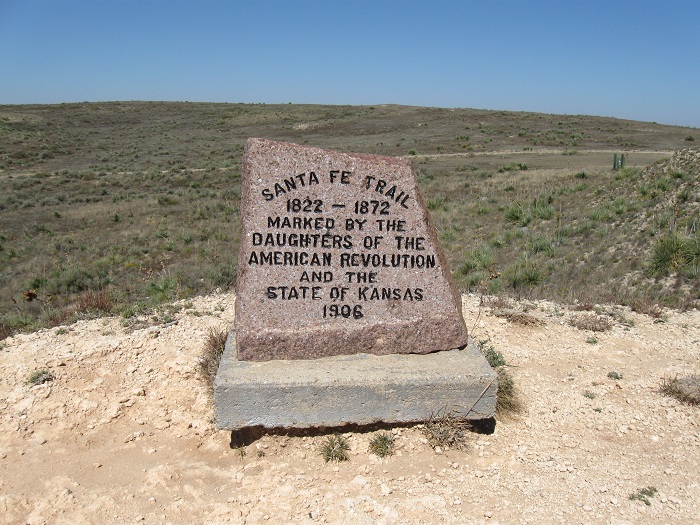By 1900, the Santa Fe Trail was already history. If asked to locate the Trail, very few people could do so. The Kansas Daughters of the American Revolution (DAR) set out to change that in 1902 with a plan to mark the old commerce route as a tribute to the brave pioneers who traversed it. “Those early travelers prized the old Trail as a road to the future, and we hope the people of years to come will use it and keep its early history in remembrance.”
The DAR enlisted the aid of maps, the knowledge of early settlers, the Kansas State Historical Society and some previously erected markers to trace the route of the SFT. At a Trail Committee meeting in 1905, the Daughters decided to ask the school children of Kansas to contribute a penny each toward the marking of the Trail since the funds appropriated by the State were not enough to pay for all the markers. On Kansas Day 1906, which was also designated as Trail Day, Lakin students brought their pennies to school, collecting around $2 towards the project.
In 1907, the DAR announced that 96 markers had been placed throughout Kansas. Kearny County’s markers arrived by rail in July of that year, and commissioners paid the expense of setting the five stones. Since Kearny County did not have a DAR chapter, County Clerk and Lakin pioneer F.L. Pierce gave prompt and efficient attention to the task of having the markers placed. One marker was erected in Deerfield in what is now the city park. In Lakin, one monument was set at the old courthouse at the corner of Main and Waterman. This marker was moved to the current courthouse in 1939. Another marker was placed at the site of the 1886 school just east of Buffalo Street but was moved to Lakin High School in 1961.
Hartland’s Main Street was the location of the fourth marker. As Hartland gradually disappeared, the marker was engulfed in weeds. Billy Carter was cultivating the ground and put a long chain around the marker and pulled it over to his house. Later the DAR Chapter of Garden City secured the assistance of the highway commission and had the marker moved to the River Road where it intersects the once Main Street of Hartland.
The final marker was placed between Lakin and Deerfield at Long Schoolhouse. For several years after the school closed, the marker remained where it was placed by the side of the highway. As the story goes, a young man who was opening a filling station in Lakin thought the marker would look good on the station grounds and brought it to Lakin. It is believed that this marker is the one that now sits atop Indian Mound and is pictured at the end of this article.
The dates for the SFT that the DAR had engraved on the markers (1822-1872) are a somewhat controversial topic among trail enthusiasts. The Santa Fe Trail Association recognizes the start of the trail as 1821 when William Becknell first ventured to Santa Fe and disposed of his trade goods. The Story of the
Marking of the Santa Fe Trail by the Daughters of the American Revolution in Kansas and the State of Kansas claims, “The earliest use of the Trail was in 1822, when a caravan left Boonville, Mo., by way of Lexington, Independence, Westport (now Kansas City, Mo.), thence in a southwesterly direction across the great State of Kansas, then only a desert and wilderness, and on to Santa Fe, New Mexico.” The DAR used 1872 because that it is the year that the Atchison, Topeka & Santa Fe Railroad was finished through Kansas, but many contend that the trail actually ended in 1880 when the railroad reached Santa Fe. In 1996, a plea was made in the quarterly newsletter of the Santa Fe Trail Association to press for historical accuracy, but the original engraved dates remain. Nonetheless, more important than the dates on the granite markers is the fact that had the Daughters not marked the historic route when they did, the location of the Santa Fe Trail could have been lost forever.
Sources: “The Story of the Marking of the Santa Fe Trail by the Daughters of the American Revolution in Kansas and the State of Kansas” by DAR Historian Mrs. T.A. Cordry, “History of Kearny County Kansas Vol. I”, Advocate archives from 1906, Kansapedia, Kansas State Historical Society, www.santafetrailresearch.com and www.dar.com.

